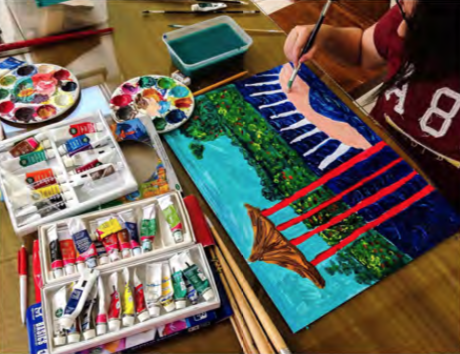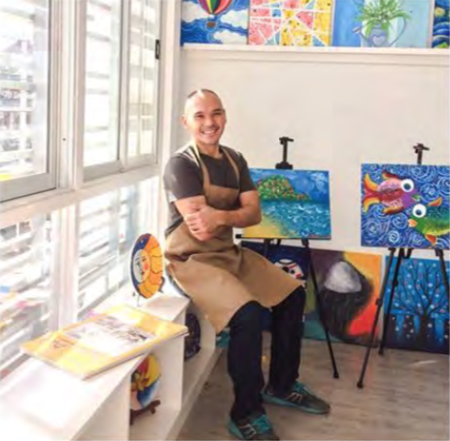Artist and special education consultant/educator Amos Manlangit conducts special sessions to advocacy, corporate and special interest organisations through mandala plate painting, a self-discovery workshop that emphasizes the values of visioning, well-being, stress management, leadership, creative and divergent thinking, resilience and grit. He was a recent participant at the Arts and Disability International Conference (ADIC), held on 22-23 March 2018 at the Sands Expo Convention Centre and Enabling Village in Singapore. He shares his thoughts on how the arts impacts disability through three mediums.
In what ways can art be purposeful to a person with disability?
Art engages every person in various ways. For many, it may start from as simple as a relaxing and meditative experience. Others find it as a channel to communicate and express their ideas in different forms. Art empowers a person in a way that goes beyond its traditional purpose of being decorative or for its own sake.
In society, art reflects the sentiments and experiences of its people. Art making should therefore be participated by everyone if it seeks to represent collective thoughts.
But in the paradigm of disability, persons with physical impairments or learning difficulties may not able to creatively realise themselves due to the restrictions set by their environments. They may find it limiting if the process entails methods that do not correspond to their needs, or if their disability becomes a reason for their exclusion. This becomes a barrier for them to pursue their passions and contribute to their society’s creative aspirations.
In my experience working with people with disabilities, I have witnessed how some managed to get through these and achieve an enriched form of creativity that levels the playing field with their able-bodied counterparts. There are impressive painters, musicians, singers, dancers, dramatists, writers and performers who are recognized for their artistry and not because of their disability.
In my recent participation in the 2018 Arts and Disability International Conference (ADIC) in Singapore, I realised how the arts play a transformative role in reshaping our thinking about disability and people with disabilities. The conference provided a ground to discuss the sentiments of educators, artists, psychologists and allied professionals in how to put down the attitudinal, environmental and institutional barriers that disable them.
the arts play a transformative role in reshaping our thinking about disability and people with disabilities. The conference provided a ground to discuss the sentiments of educators, artists, psychologists and allied professionals in how to put down the attitudinal, environmental and institutional barriers that disable them.
How does art impact disability in an individual and societal level? In my experience and study, I have observed three ways by which it serves a purpose. These are for therapeutic gains, creative self-actualisation, and for advocacy building.
1. Art as their therapeutic medium
The arts can engage a person with a disability on a psychological level as it nurtures his mental and emotional wellbeing. There are three ways by which it helps therapeutically. First, the mindfulness benefit inherent in the creative process increases focus and clarity, allowing a person to flow into artistic activity for extended periods. For instance, individuals with Attention Deficit Hyperactivity Disorder (ADHD) may find the meditative qualities of art production helpful to increase attention span and minimize distractibility. Second, the art-maker uses it to express his thoughts and manifest it in the creative output. He may find fulfillment in sharing his ideas verbally or nonverbally. Third, he can pour his feelings into the activity, utilising action, colours and sounds, among others to release pent up emotions that may be difficult to express in words. All of these can gain for the art-maker an opportunity to reflect, process his thoughts, discover something about himself, experience a catharsis or reach a state of creative flow.
2. Art as their instrument for creative self-actualisation
Expression is natural to a human and this enables him to manifest his persona into the craft. This is by inducing a creative flow wherein he makes use of his skills to maximise his potentials. For a person with disability, flow matches his skills and abilities. It can range from simply being in-the-zone to fully articulating himself through the art. These moments can produce brilliant forms of works. In fact, many people with autism have harnessed their specific intelligences and developed these into astounding talents. The objective of an arts facilitator must therefore be to find their types of flow and harness these as artistic manifestations. This is by looking into different creative modalities that will highlight strengths, whether in the visual arts, music, writing, dance or drama. The moment the art-maker creates a piece of work and makes his audience forget about his disability, he achieves his right to be an able contributor to the arts of his community.
3. Art for advocacy building
Art is a platform to talk about diversity. In essence, it is the gateway to divergence, which is an essential component to out-of-the-box thinking. This mindset opens the door to embrace differences and consequently, promote individuality. Art provides a space for everyone to exercise creative freedom that should include persons with or without disabilities. In the abovementioned conference, UNESCO Knowledge Societies Division’s Director, Dr. Indrajit Banerjee, stressed the importance of cultural rights by which people with disabilities are entitled to fully benefit from the arts just like anyone else. Therefore, a society placing value on inclusive arts opens its thinking to find more ways and make creative opportunities accessible for all. Art then begins to play a transformative role in attaining a more inclusive environment.
About the Contributor
Amos V. Manlangit attended as a conference scholar under the Singapore International Foundation (SIF) at the Arts and Disability International Conference (ADIC), held last March 22-23, 2018 at the Sands Expo Convention Centre and Enabling Village in Singapore. This inaugural conference was a result of the success of the previous Arts and Disability Forums in 2016 and 2017. It is presented by the Nippon Foundation and jointly organised by Very Special Arts (VSA) and the National Arts Council of Singapore, with principal partners- the British Council and the SIF.



